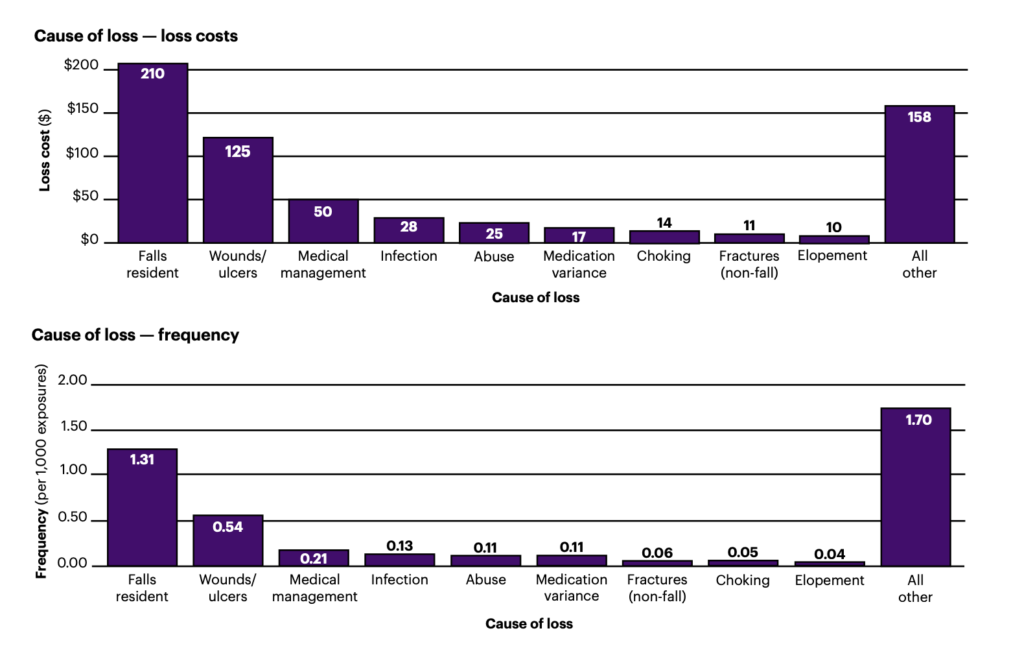
Skilled nursing and senior living liability losses have accelerated in both frequency and total cost since 2016, with per-incident costs rising nearly 12% per-year in that time period, a new national benchmarking study finds.
Choking incidents cost providers the most per incident, but falls remains the most common cause of claims, according to a Willis Towers Watson’s actuarial analysis of client claims data from the last decade. The study, published in February,included more than 15,000 claims and $2.3 billion in reported loss across settings, with 19% of clients representing skilled nursing.
Average severity — or the cost per incident — across all claims dropped 3.4% to $140,000 between this year’s study and last year’s. But the authors cautioned against reading too much into the decline as COVID conditions and, possibly, questions about liability protections, could have delayed some claims. The sector had actually seen an increase in high-cost payouts before the pandemic, a trend that in typical times leads to more frequent claims.
“The decline in severity may be related to the potential carry over from COVID, when courts were shut down, cases were backlogged, and beds remained empty,” Maryann McGivney, Healthcare & Life Sciences Industry vertical leader, said in an email. “The study data cuts off at 2021, so there is a lag between the data and the current environment. In the current environment, courts have reopened, and residents are returning. In addition, the continued decline of legal venues adds to the future uncertainty.”
In some ways, it may be that the other shoe has yet to drop.
And in some states, the liability news is already worse than the averages reveal.
WTW experts found providers faced widely varied risk environments depending on the states where they operated. In Texas, for instance, the average loss was just 10.7% of the average loss in the highest-cost state, Kentucky.
The legal implications are driving up provider costs and effecting transactions in some markets. States without tort reform or that have statutes allowing plaintiffs to recover damages for attorney fees and punitive damages contribute to increased frequency and severity of claims. States with tort reform or civil caps, meanwhile, keep averages down.
“The high variance between total loss costs in different states is creating some real practical difficulties for operators in the states reporting high losses. In some cases insurers are avoiding or restricting coverage — or aggressively increasing premium — and this is having a material impact on companies with large operations in these jurisdictions,” WTW reported. “It also impacts valuations for those operators looking to divest operations to interested new entrants, such as private equity companies, REITs and hospital systems that analyze the senior living sector.”
The study also found that the number of claims over $1 million is growing, creating a “volatility” that “has a psychological impact on underwriters.”

Choking claims result in the highest average severity at $300,000, but claims are made by just 0.05 of 1,000 residents. Falls remain the largest and most frequent driver of claims, totaling nearly one-third of all costs, followed by wounds.
While the analysis did not provide a breakdown of claim type or frequency by care setting, the authors pointed out that falls and other claims are likely being influenced by facilities’ aging populations and residents and families that resist moves to higher-acuity settings.
“This understandable reluctance – residents are loathe to see changes to their day-to-day care and families are sensitive to budgetary change – can end up transferring growing cost and risk onto operators. The extent that misclassification of acuity of care increases loss cost risks to operators is still widely unappreciated. The decision not to change care is an active decision to accept risk of future claims.”
The liability study and a related supplemental guide offer several risk management tips to help providers mitigate the chances of falls and other claims and address staffing challenges that may contribute to lawsuits.



